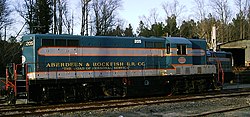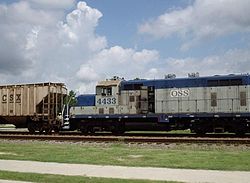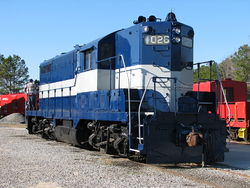| Owner | Quantity | Numbers | Notes |
|---|
| Electro-Motive Division (demonstrator) | 1 | 525 | 1350 hp GP7m; to Atchison, Topeka and Santa Fe 99, renumbered 2899 [11] This unit was built with a 567BC engine. |
| 3 | 100 (ex-852), 200, 300 | to Chicago & North Western 1518–1520. 1518 first built, preserved and operating at Illinois Railway Museum |
| Aberdeen and Rockfish Railroad | 1 | 205 | |
| Atchison, Topeka and Santa Fe | 244 | 2650–2893 | 2855-2858 were built with 567C engines |
| 5 | 2788A–2792A | GP7B; 2788A-2789A, 2791A-2792A were built with 567C engines |
| Atlanta and St. Andrews Bay | 2 | 501–502 | |
| Atlanta and West Point Rail Road | 5 | 571–575 | |
| Atlantic and East Carolina Railway | 1 | 501 | Renumbered 406. |
| Atlantic Coast Line Railroad | 154 | 100-253 | |
| Baltimore and Ohio Railroad | 33 | 720–731, 740–746, 910–922, 6405 | 728-729; 740-746 were built with 567BC engines; Long-hood-forward |
| Bangor and Aroostook Railroad | 16 | 560–575 | |
| Belt Railway of Chicago | 8 | 470–477 | |
| Boston and Maine Railroad | 23 | 1555–1577 | |
| Butte, Anaconda and Pacific Railway | 3 | 101–103 | |
| Central of Georgia Railway | 15 | 106–107, 120–132 | |
| Central Railroad of New Jersey | 13 | 1520–1532 | |
| Atlantic Coast Line Railroad (Charleston and Western Carolina Railway) | 21 | 200–220 | To Atlantic Coast Line 254-274 |
| Chesapeake and Ohio Railway | 180 | 5700–5719, 5739–5797, 5800–5900 | 5720–5738 built by GMD |
| Chicago and Eastern Illinois Railroad | 30 | 203–232 | |
| Chicago and North Western Railway | 110 | 1521–1550, 1556–1559, 1562–1599, 1601–1603, 1625–1659 | |
| Chicago and North Western (Chicago, St. Paul, Minneapolis and Omaha Railway—"Omaha Road") | 11 | 151–161 | |
| Chicago, Burlington and Quincy Railroad | 68 | 200–267 | 253-267 were built with 567BC engines |
| Chicago Great Western Railway | 2 | 120–121 | |
| Chicago, Rock Island and Pacific Railroad | 113 | 430–441, 1200–1237, 1250–1311, 1308 (2nd) | 1294-1299 were built with 567BC engines |
| Clinchfield Railroad | 17 | 900–916 | |
| Colorado and Wyoming Railway | 2 | 103–104 | Engines 103 & 104 are owned by the Pueblo Railway Foundation. Both locomotives are operable and used occasionally on Museum grounds. |
| Colorado Fuel and Iron | 2 | 101–102 | Engine 102 is owned by the Pueblo Railway Foundation. The locomotive is operable and used occasionally on Museum grounds. |
| Atlantic Coast Line Railroad (Columbia, Newberry and Laurens Railroad) | 5 | 100–104 | To Atlantic Coast Line 275-279 |
| Delaware, Lackawanna and Western Railroad | 20 | 951–970 | To Erie Lackawanna, 1270-1284, 1405-1409. |
| Denver and Rio Grande Western Railroad | 14 | 5100–5113 | |
| Detroit and Toledo Shore Line Railroad | 10 | 41–50 | |
| Detroit, Toledo and Ironton Railroad | 24 | 950–973 | 964-973 were built with 567BC engines |
| Erie Railroad | 52 | 1200–1246, 1400–1404 | To Erie Lackawanna, same numbers |
| Florida East Coast Railway | 15 | 607–621 | |
| Georgia and Florida Railroad | 6 | 701–706 | |
| Georgia Railroad | 16 | 1021–1036 | 1035-1036 were built with 567BC engines |
| Great Northern Railway | 56 | 600–655 | Long-hood-forward |
| Illinois Central Railroad | 48 | 8800–8801, 8850–8851, 8900–8911, 8950–8981 | 8800–8801, 8900–8911 had steam generators |
| Illinois Terminal Railroad | 6 | 1600–1605 | |
| Kansas City Southern Railway | 8 | 155–162 | |
| Kansas City Southern (Louisiana and Arkansas Railway) | 5 | 150–154 | |
| Kansas, Oklahoma and Gulf Railway | 9 | 801–809 | |
| Louisville and Nashville Railroad | 61 | 400–440, 500–514, 501–502 (2nd), 550–552 | |
| Maine Central Railroad | 19 | 561–569, 571–580 | 566-569 were built with 567BC engines |
| Meridian and Bigbee Railroad | 1 | 1 | Renumbered 101 |
| Midland Valley Railroad | 4 | 151–154 | |
| Minneapolis, St. Paul and Sault Ste. Marie Railroad ("Soo Line") | 7 | 375–378, 381–383 | |
| Missouri Pacific Railroad | 208 | 4116–4194, 4197–4325 | 4116-4120, 4159-4165, 4203-4207, 4249-4253, 4284-4286, 4323-4324 owned by St. Louis, Brownsville and Mexico, 4121-4123, 4153-4158, 4197-4202, 4254-4255, 4287-4297, 4325 owned by International-Great Northern, 4290-4291, 4316-4320, 4325 were built with 567BC engines; 4292-4315, 4321-4324 were built with 567C engines. |
| Missouri–Kansas–Texas Railroad | 33 | 1501–1529, 1761–1764 | 1700s had steam generators; Renumbered 91–123 |
| Nashville, Chattanooga and St. Louis Railway | 37 | 700–731, 750–754 | 700-705 built with EMD AAR TypeA trucks |
| Ferrocarriles Nacionales de México (National Railways of Mexico) | 2 | 6600–6601 | |
| New York Central Railroad | 169 | 5600–5611, 5626-5675, 5686-5712, 5738-5817 | Long-hood-forward |
| New York Central Railroad (Peoria and Eastern Railway) | 14 | 5612-5625 | Long-hood-forward |
| New York Central Railroad (Pittsburgh and Lake Erie Railroad) | 35 | 5676-5685, 5713-5737 | Long-hood-forward |
| New York, Chicago and St. Louis Railroad ("Nickel Plate Road") | 48 | 400–447 | |
| Northern Pacific Railway | 20 | 550–569 | to Burlington Northern Railroad 1624–1643; [8] 560-569 were built with 567BC engines |
| Pennsylvania Railroad | 66 | 8500–8512, 8545–8587, 8797–8806 | Long-hood-forward |
| Phelps Dodge Corporation | 7 | 1–2, 7–8, 27–29 | |
| Portland Terminal Company Maine | 1 | 1081 | |
| Reading Company | 44 | 600–636, 660–666 | 625-636 were built with 567BC engines; Long-hood-forward |
| Richmond, Fredericksburg and Potomac Railroad | 4 | 101–104 | |
| Seaboard Air Line Railroad | 123 | 1700–1822 | |
| Southern Railway | 57 | 2063–2077, 2156–2197 | |
| Southern Railway (Cincinnati, New Orleans and Texas Pacific Railway) | 11 | 6200–6205, 6240–6244 | |
| Southern Railway (Alabama Great Southern Railroad) | 5 | 6540–6544 | |
| Southern Railway (Georgia Southern and Florida Railway) | 4 | 8210–8213 | |
| St. Louis Southwestern Railway | 1 | 320 | Renumbered 304 |
| St. Louis–San Francisco Railway | 129 | 500–549, 555–632, 615 (2nd) | |
| Tennessee, Alabama and Georgia Railway | 3 | 707–709 | |
| Texas and Pacific Railway | 21 | 1110–1130 | |
| Texas Mexican Railway | 3 | 850–852 | |
| Toledo, Peoria and Western Railway | 2 | 102–103 | |
| Union Pacific Railroad | 30 | 700–729 | 720-729 were built with 567BC engines |
| United States Army | 20 | 1821–1840 | Built with EMD AAR TypeA trucks; 12 later served on Alaska RR and 11 were retrucked with AAR Type B road trucks |
| Wabash Railroad | 33 | 450–452, 454–483 | 453 built by GMD |
| Western Maryland Railway | 4 | 20–23 | |
| Western Pacific Railroad | 13 | 701–713 | |
| Western Railway of Alabama | 6 | 521–526 | |
| Totals | 2,617
5 | GP7
GP7B | |
|---|





